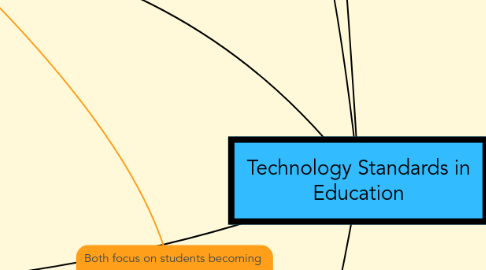Technology Standards in Education
by Nimrat Johal

1. 3. Processes for Productivity: Students learn how to become efficient whilst using technology as they are able to identify which tools are best for different tasks.
2. ISTE Standards for Students (2016)
2.1. 1. Empowered learner: Enable students to take an active role in their learning whilst personalizing learning objectives and applying them to their own lives.
2.2. 2. Knowledge constructor: Empower students to construct meaningful learning experiences whilst being able to use a variety of resources.
2.3. 3. Computational Thinker: Encourage students to effectively and efficiently take advantage of the right type of technology when they need to.
3. ISTE Standards for Teachers (2008)
3.1. 1. Facilitate and inspire student learning and creativity: To guide and encourage students to learn and be creative in their own personalized ways in virtual and non-virtual settings.
3.2. 2. Design and develop digital age assessments and learning: Maximize the learning outcomes by using a variety of digital assessment tools to ensure each student gets an opportunity to display their strengths.
3.3. 3. Professional growth and leadership: Take on the notion of life-long learning by trying out new methods and continually reflecting on your teaching practices.
4. Learning and Technology Policy Framework (2013)
4.1. 1. Student Centred Learning: Allows for students to independently develop their personal learning style, think critically, manage information, apply multiple concepts and collaborate with one another.
4.2. 2. Research and Innovation: Active participation in research and innovation which allows for educators to remain current with technological practices as it helps address areas of concern.
4.3. 3. Professional Learning: Building a sense of confidence and self-efficacy among educators when it comes to using technology to help ensure both students and educators get the most out of technological practices.
5. Information and Communication Technology (2000-2003)
5.1. 1. Communicating, inquiring, decision making and problem solving: Allows for students to develop higher order thinking skills which will help them critically think about the world they live in.
5.2. 2. Foundational operations, knowledge and concepts: Students learn why it is important to know how to use technology along with the ethical guidelines in regards to technology in a globalized world.


